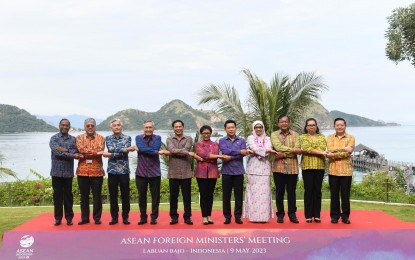
Secretary Manalo (second from left), together with ASEAN Secretary-General Dr Kao Kim Hourn and tthe foreign ministers of the nine remaining ASEAN member states attend the ASEAN Foreign Ministers’ Meeting in Labuan Bajo, Indonesia on May 9 leading up to the 42nd ASEAN Summit and Related Meetings. (Photo courtesy of ASEAN)
MANILA – The Philippine government underscored on Tuesday the need to reinforce the Association of Southeast Asian Nations (ASEAN) centrality amid what it calls “unprecedented” and more complex challenges that the region faces today.
During the ASEAN Foreign Ministers’ Meeting in Indonesia, Foreign Affairs Secretary Enrique Manalo said one way of doing this is to implement the ASEAN Outlook on the Indo-Pacific.
“As we seek ways to reinforce our Centrality, I think it is important that we seek ways on how to project our Centrality outward. We need to ask how ASEAN can matter not just to our circle of ten, soon to be eleven, but to the larger region and the world,” he said in his remarks.
ASEAN centrality is defined as the need for the bloc to become the center of regional architecture in Southeast Asia and its surrounding regions.
The call was made against the backdrop of tensions and heightened uncertainties amid regional developments, including the tensions on the Taiwan Strait, the ongoing Russia-Ukraine war, North Korea's ballistic missile tests in the Korean Peninsula, and the South China Sea rows.
Under the ASEAN Outlook on the Indo-Pacific, the bloc seeks to create an enabling environment for peace, stability, and prosperity in the region by addressing common challenges, upholding the rules-based regional architecture, and promoting closer economic cooperation.
It seeks to strengthen its existing mechanisms with external partners, including the East Asia Summit, consisting of the 10 ASEAN member states, Australia, China, India, Japan, New Zealand, South Korea, Russia, and the United States.
It also aims to implement other areas of cooperation centered on maritime cooperation, connectivity, the Sustainable Development Goals, and economics, among others.
“For five decades, ASEAN Centrality has been in a way our north star, and it has successfully guided our engagements with the world. But the challenges we face today are certainly complex and more interconnected than ever, and our Centrality is being tested in unprecedented ways,” Manalo said.
“Lest we become a victim of our own success and become overburdened, we must channel this greater interest into high-quality engagements, with a robust agenda that puts ASEAN’s profile and interests front and center.”
Manalo and the other foreign ministers of the nine ASEAN member states met on the sidelines of the 42nd ASEAN Summit in Labuan Bajo, Indonesia.
Timor-Leste, set to become the bloc's 11th member, was present as an observer. (PNA)
